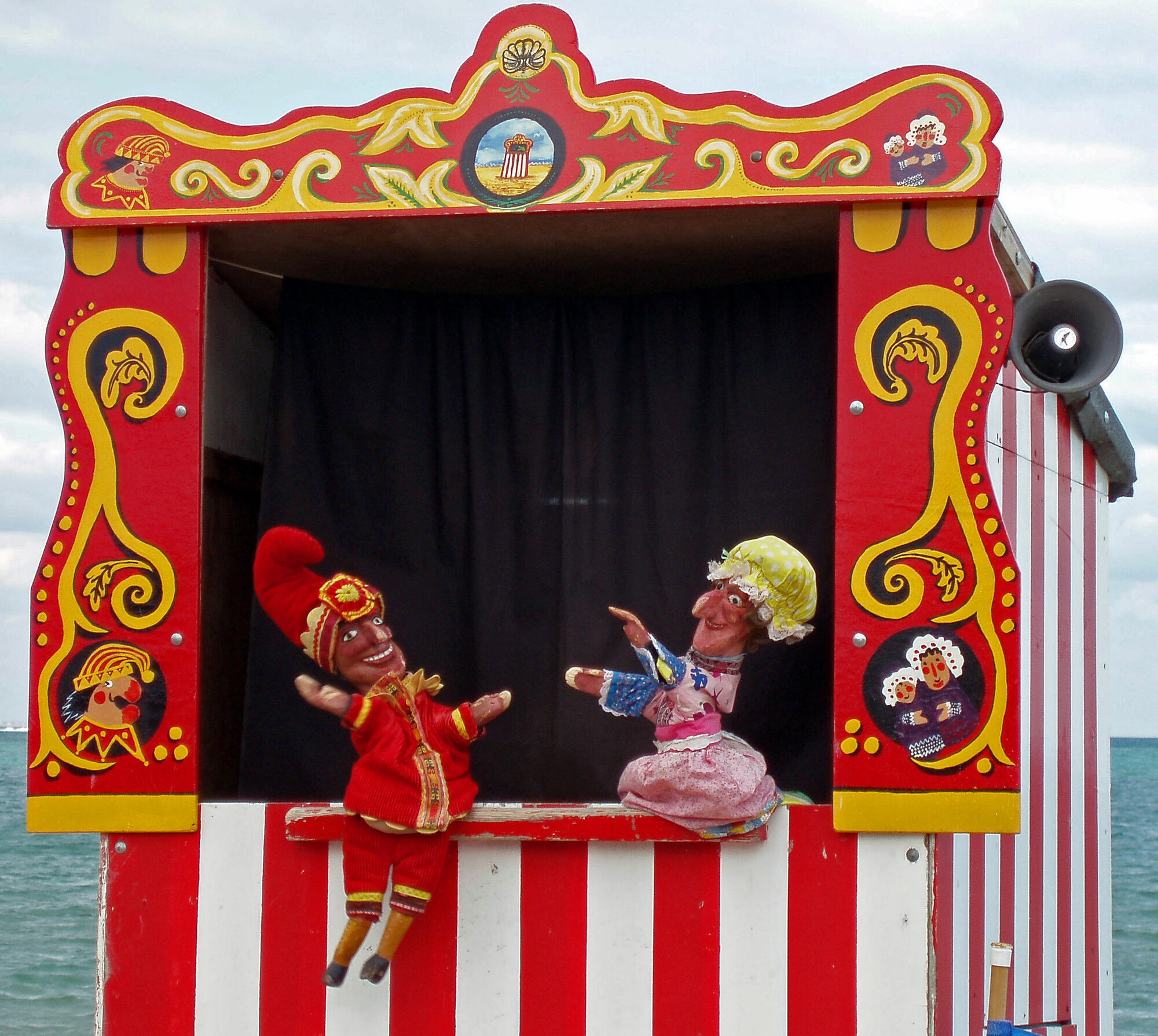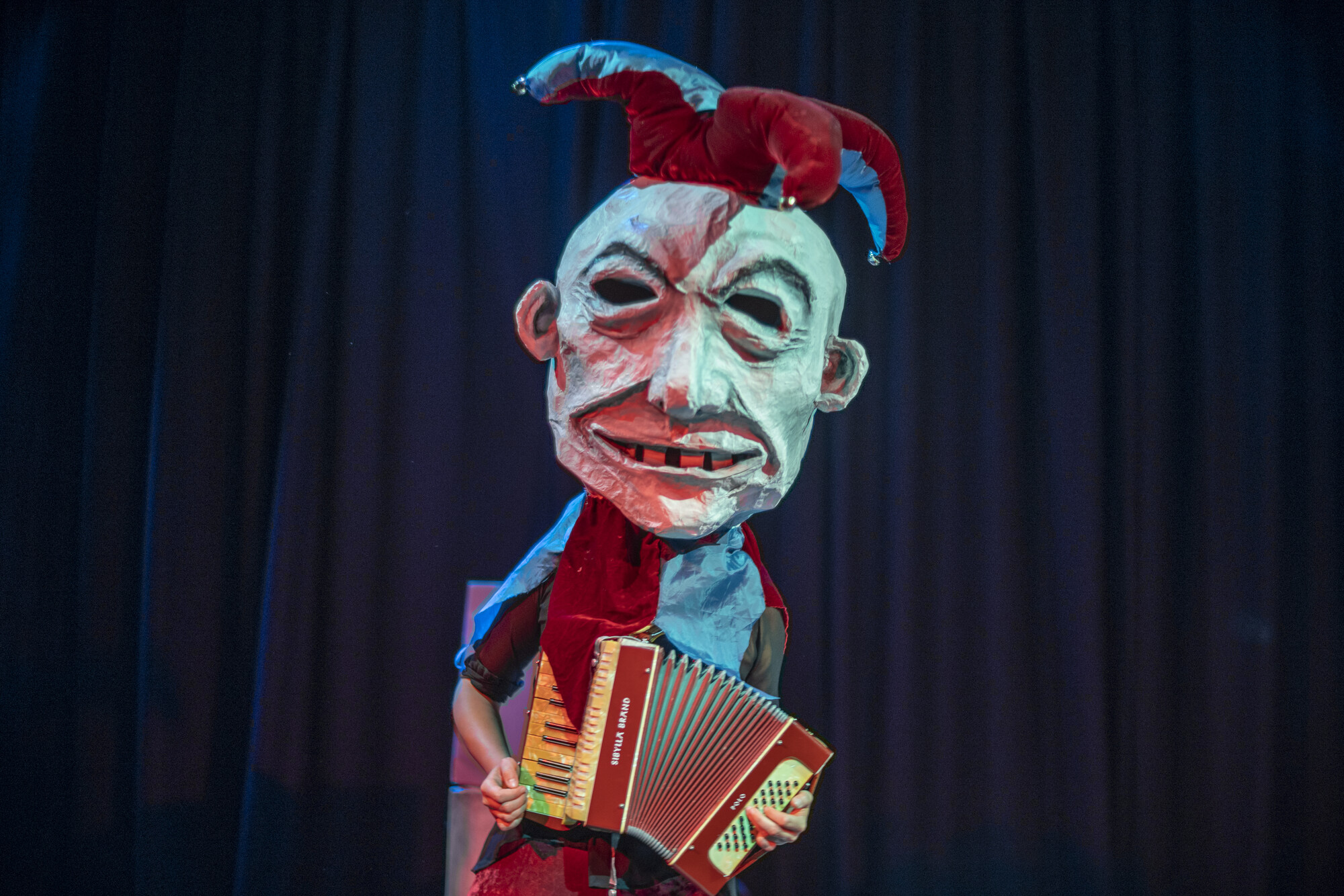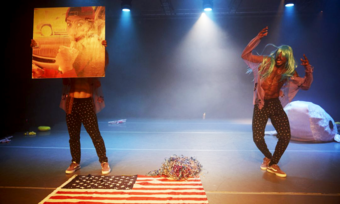Imagine coming home and hearing the screams of your neighbors. You hear the cries of a baby as you peek through your curtains. Suddenly your neighbor appears holding out a large stick and begins beating his wife and baby mercilessly, laughing and cackling cruelly with each blow. A short while later, you see a policeman knock at the door. The man answers, and you hold your breath. There is a loud whack, and the policeman falls to the ground dead. You are so shocked you don’t notice the second policeman, who takes a shot at the man. There is another whack, and he is dead, too. A moment later, you hear a burning inferno as the devil himself arrives, ready to take the man to hell for his crimes. You know the man is in for it, but then—whack!—the devil, too, is thwarted. The man stands over him, squeaking hysterically with a high-pitched giggle. This is a familiar scene from the life of Mr. Punch, a small sixteenth century Italian puppet whose wickedness and violence has been a source of controversy—as well as hilarity—for millions. Over the centuries, the Mr Punch puppet has been accused of creating scenes of domestic violence, promoting racist undertones, and having the potential to upset vulnerable children. Despite this blatant controversy, the king of misrule has managed to survive and evade becoming obsolete. What is it about Punch’s character that has allowed him to keep his crown?
Pietro Gimonde, an Italian puppeteer, introduced Punch, also known as Policinella, to British audiences during the sixteenth century. The small puppet is witty, charming, and often violent. He is often depicted with clown-like features, a large hooked red nose, an unsettling smile, and the colorful attire of a court jester. He can be seen whipping his battered wife, Judy, with a slapstick and dropping his baby in a meat grinder, and Punch gets away with it every time. He became a popular symbol of anarchy and mischief among the working classes. Punch was seen as a rebel who broke the mold of social hierarchy and stood up for individual freedom. His persona and his comical appearance could draw a large crowd and encourage audience participation. To this day, Punch is recognized as a cultural icon and the king of puppets.
But Punch’s reputation is also controversial. Over the years, concerned parents, schools, and commentators have argued that the violent content of a Punch and Judy show isn’t appropriate for children and that it needs to be adapted for a modern audience or removed completely. Even Good Morning Britain has taken up the question of “Is Punch and Judy Outdated?” While some Punch and Judy puppeteers have adapted their shows to be less violent, performers like Brian Llewellyn refuse to change their Punch and Judy shows. They say that they value the traditions and essence of Punch's character, but what exactly is the essence of Punch?
Is Puppet Violence Real?
My first experience of Punch was in Punch and Judy, a 1966 stop-motion short film by Czech animator Jan Svankmajer. In the film, Punch is quarreling with another puppet over the custody of a live guinea pig. The puppets fight to the death, ripping each other apart until they both collapse inside a coffin. Their fight is brutal, reminding the viewer of how ruthless humans can be when money and sacred objects (guinea pigs) are involved.
Puppets can reach beyond mere children’s entertainment to teach us something about our own moral codes and virtues.
Punch is a symbolically violent character, and this violence speaks to the anarchic and brutal side of human nature. Julian Crouch from Improbable Theatre describes violence on stage as the theatrical metaphor for conflict. It's not real violence; it’s symbolic of the emotional tension people feel when confronting opposition. The puppets are acting out a universal pattern of human behavior, one that feels timeless and familiar to us. One could frame the conflict as an economic struggle as the two characters fight over who should own and profit from the guinea pig. Or perhaps the conflict is cultural, and the guinea pig could represent a victim who the two characters are trying to “save.” In either case, the symbolic imagery of the guinea pig subverts what might seem like violence.
In the film, the violence is whimsical and childlike. For example, Mr. Punch's hammer makes a gentle and almost pleasant “glock” sound as it comes down over his opponent's head. Towards the end of the film, the puppets rip each other apart, breaking noses and chipping paint—but there is no blood. The viewer knows the puppets aren’t real and are only made of papier mâché. Svankmajer deliberately shows the puppeteer’s hands, further exposing the illusion and conveying that the puppets and the violence are manifestations of our own imagination.
Jan Svankmajer has used the archetypal character of Punch to explore universal moral and political issues that have relevance in today’s political and social climate. He emphasizes symbolic violence as a tool to express confrontation, showing us that puppets can reach beyond mere children’s entertainment to teach us something about our own moral codes and virtues.



















Comments
The article is just the start of the conversation—we want to know what you think about this subject, too! HowlRound is a space for knowledge-sharing, and we welcome spirited, thoughtful, and on-topic dialogue. Find our full comments policy here
Beautiful article... The penetration of Punch and Judy can be seen in many visual art forms ... current day animation from Tom and Jerry to Family Guy makes effective use of violence and character prerogatives as outlined. It may be that some parents are repulsed by Punch and Judy as puppets but both are everywhere around us ... more recently seen in US politics or day time tv...and so it is a proven fact they strike a chord and both cut very deep as archetypes. On top of that Punch and Judy the puppets direct their violence towards a conclusion and it could be argued violence is not there for the sake of it or just confined to it but serving a'different if not 'higher purpose' and fulfilling a true social function... something mostly amiss in US cinema and games today if not the theatre.